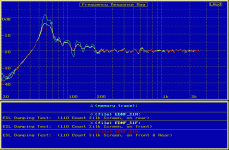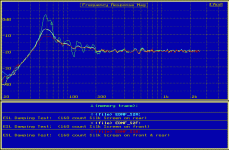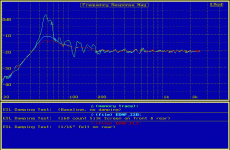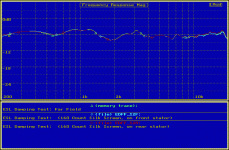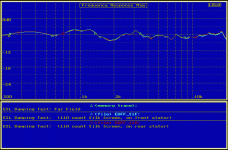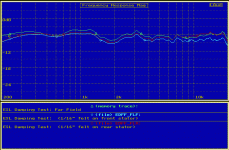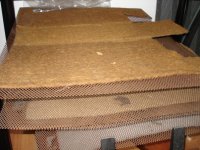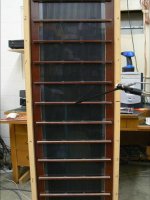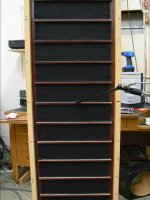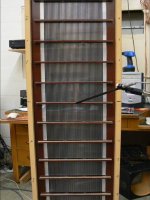I was in an art supply store with my daughter a few months ago and came across some nylon mesh used for silk screening.It looked almost identical to the the damping material used in the ESL63.
Andrew
Thanks for the info, I'll have to swing by an art supply shop and check it out.
Do you know, is the damping mesh used in the ESL63 is stretchy like grill cloth?
Or is it pretty dimensionally stable.
Hi SY,
The few Acoustat panels I have seen used some fairly thick felt damping pads in the middle 1/3 area of the panel, and nothing on the outter area. Did you remove these pads before applying your thin felt? You mention only applying the damping to 50% of the active area. Can you describe where/why you applied the damping? Any Pics?
bolserst
The original pads had been removed long before I ever got the panels. I put thin (~1mm) felt in approximately the same location and area as the original thick felt. I needed less damping because of my material choice for the diaphragms, a softer, less "crinkly" polymer than Mylar (H-series Clysar). It's now sadly been discontinued and I'm looking for a good substitute. One possibility, if I can get any in a thin enough gauge, is an ethylene-norbornene copolymer.
Thanks for the info, I'll have to swing by an art supply shop and check it out.
Do you know, is the damping mesh used in the ESL63 is stretchy like grill cloth?
Or is it pretty dimensionally stable.
I checked and it doesn't stretch
Andrew
I was in an art supply store with my daughter a few months ago and came across some nylon mesh used for silk screening.It looked almost identical to the the damping material used in the ESL63.
Andrew
I finally got a chance to check out the silk screen mesh. It is available in hole counts from about 60 holes per inch, to over 300 holes per inch. The thread size is reduced with increasing hole count, so the percent open area remains in the 60% - 70% range. With a mesh that is this open I wondered if it would supply much low frequency damping. But, on the other hand, it gives me hope that there will be minimal impact on the higher frequencies.
Originally when I saw that the percent open area was the same for all the meshes, I thought that the resistive damping would be the same. But, I did a few google searches on acoustic screen dampers and found an online book with a chapter on the topic...."It is important to note that for a constant open area the resistance increases and the reactance drecreases with n(holes per inch). The basic reason for this behavior is that the channel resistance is inversely proportional to the square of the width of the air channel between adjacent wires, and the reactance is proportional to the thickness of the screen."
With this is mind, I ordered a sample of three different hole counts with the idea of getting some damping trend data. I will post what I find out.
Silk Screen Mesh: Damping of ESL diaphragm resonance
I had ordered some 110, 160, and 200 count silk screen mesh, but the 200 count was on back order. So I have thrown some 1/16” felt in to the mix will I was in the measurement mode.
The 110 count mesh uses 78 µm monofilament polysester fibers (66% open area)
The 160 count mesh uses 64 µm monofilament polysester fibers (60% open area)
The ESL panel used for the test was 60” tall x 8” wide, with 2 rows of assymetrically placed silicon dampers. The undamped curves(Green) show a double bumped resonance peak caused by placement of the silicon dampers as mentioned by Capaciti earlier in this thread. Microphone was placed 1” in front of the midpoint of the diaphragm.
1) Damping results for 1/16” felt on the rear stator
2) Damping results for 110 count mesh, on front stator, rear stator, and both stators
3) Damping results for 160 count mesh, on front stator, rear stator, and both stators
4) Comparison of 1/16” felt .vs. 160 cound mesh.
As you can see, down to 80Hz, the 160 count mesh damps as well as the felt.
The 200 count mesh should be even better.
I had ordered some 110, 160, and 200 count silk screen mesh, but the 200 count was on back order. So I have thrown some 1/16” felt in to the mix will I was in the measurement mode.
The 110 count mesh uses 78 µm monofilament polysester fibers (66% open area)
The 160 count mesh uses 64 µm monofilament polysester fibers (60% open area)
The ESL panel used for the test was 60” tall x 8” wide, with 2 rows of assymetrically placed silicon dampers. The undamped curves(Green) show a double bumped resonance peak caused by placement of the silicon dampers as mentioned by Capaciti earlier in this thread. Microphone was placed 1” in front of the midpoint of the diaphragm.
1) Damping results for 1/16” felt on the rear stator
2) Damping results for 110 count mesh, on front stator, rear stator, and both stators
3) Damping results for 160 count mesh, on front stator, rear stator, and both stators
4) Comparison of 1/16” felt .vs. 160 cound mesh.
As you can see, down to 80Hz, the 160 count mesh damps as well as the felt.
The 200 count mesh should be even better.
Attachments
Last edited:
Silk Screen Mesh: Effects on High frequency response of ESL
Microphone was placed 1 meter in front of the midpoint of the diaphragm
1) Effect of 1/16” felt place on the front stator, or the rear stator
2) Effect of 110 count mesh, on the front stator, or rear stator
3) Effect of 160 count mesh, on the front stator, or rear stator
Felt on the front stator progressively filters out more with increasing frequency.
Felt on the rear stator is interesting in that it filters out the midrange but actually boosts the highs.(reflections from the felt? Or cavity resonance effect?)
Both of the silk screen meshes had essentially no effect on the response.
Thanks again to Atom666 for suggesting the silk screen. The results are much better than any other woven cloth I had tried, providing significant LF damping without affecting the HF response.
The panel sounded like it measured. Adding LF damping with the 160 count silk screen(or felt) tightened up the LF response. Drums had noticeably more impact with the damping in place. When the felt was added to the rear stator you can notice slight loss of detail and "sparkle" in the midrange. I could not tell any difference in the midrange when the silk screen mesh was added.
Microphone was placed 1 meter in front of the midpoint of the diaphragm
1) Effect of 1/16” felt place on the front stator, or the rear stator
2) Effect of 110 count mesh, on the front stator, or rear stator
3) Effect of 160 count mesh, on the front stator, or rear stator
Felt on the front stator progressively filters out more with increasing frequency.
Felt on the rear stator is interesting in that it filters out the midrange but actually boosts the highs.(reflections from the felt? Or cavity resonance effect?)
Both of the silk screen meshes had essentially no effect on the response.
Thanks again to Atom666 for suggesting the silk screen. The results are much better than any other woven cloth I had tried, providing significant LF damping without affecting the HF response.
The panel sounded like it measured. Adding LF damping with the 160 count silk screen(or felt) tightened up the LF response. Drums had noticeably more impact with the damping in place. When the felt was added to the rear stator you can notice slight loss of detail and "sparkle" in the midrange. I could not tell any difference in the midrange when the silk screen mesh was added.
Attachments
Last edited:
Hi
Glad I could contribute something of worth.Do you think having the mesh on the inside of the speaker in close proximity to the diaphragm ,as in the ESL63 ,would give the similar results?
Andrew
Glad I could contribute something of worth.Do you think having the mesh on the inside of the speaker in close proximity to the diaphragm ,as in the ESL63 ,would give the similar results?
Andrew
Hi
Glad I could contribute something of worth.Do you think having the mesh on the inside of the speaker in close proximity to the diaphragm ,as in the ESL63 ,would give the similar results?
Andrew
All these measurements were done with the mesh or felt mounted on the outside of the stator.
Previously, I had thought that mounting tightly woven cloth on the inside of the stator closer to the diaphragm would provide better damping than when it was mounted outside the stator. However, I tried this 2 weeks ago, and the LF damping was identical between the two mounting techniques. I did not compare high frequency effects.
It is much easier to mount and swap samples on the outside of the stators, so I have continued using this placement. In the end, I figured if I could use fine mesh on the outside of both front and rear stators this would go a long way in helping to keep dust from collecting on the diaphragm and stators.
Yes there is, it's a some sort of natural fibre cloth on the inside of the back grill.
Some people like to take it out because of poor bass performance, but that is because the speakers are old and the bass gets weaker (lowered sensitivity) and the resonance frequency shifts up in frequency (sometimes over 100Hz!). The cure is to repair the panels and leave the damping mats in, that way it goes all the way down to 40 Hz, and the bass can sound surprisingly well.
This is one speaker that does not sound better without damping material. In fact it will lose it's wonderful natural midrange if you do.
NO!
The bass panels do/did NOT have any damping material at all. Period.
It was the treble unit that had the felt dampening in the back of the panel.
An externally hosted image should be here but it was not working when we last tested it.
Last edited:
NO!
The bass panels do/did NOT have any damping material at all. Period.
It was the treble unit that had the felt dampening in the back of the panel.
An externally hosted image should be here but it was not working when we last tested it.
You are ill informed, Jarre.
The picture you show has the back grill removed. This metal grill originally has a sheet of natural fibre cloth on the inside (attached with a sticky tar like substance to the grill) which damps the main resonance peak of the bass panels. This is a simple fact, no point in arguing about it.
How do I know this? Well I've actually seen 'a couple' of Quad ESLs 😀
The picture you show has the back grill removed. This metal grill originally has a sheet of natural fibre cloth on the inside (attached with a sticky tar like substance to the grill) which damps the main resonance peak of the bass panels.
Arend-jan,
When the grill+damping cloth are in place, do you know what the distance would be between the diaphragm and the damping cloth?
Would you happen to have any pictures of the inside of the back grill showing this cloth?
Thanks for the info.
Previously, I had thought that mounting tightly woven cloth on the inside of the stator closer to the diaphragm would provide better damping than when it was mounted outside the stator. However, I tried this 2 weeks ago, and the LF damping was identical between the two mounting techniques. I did not compare high frequency effects.
Just wanted to add a note about comparison of damping affects with cloth mounted inside the stator .vs. outside the stator. I was looking back over my measurements, and again noted that the damping of the fundamental resonance was the same. However, damping of the higher frequency diaphragm modes was slightly improved with the cloth mounted inside the stator, closer to the diaphragm. Not a huge improvement, but measureable.
Last edited:
Hi Bolsert,
Do you have any photos of your test set-up of the damping materials?
I thought I described the setup pretty well in post #25 and #26 where I showed the results.
The testing was done on a panel similar in size and construction to those used by Capaciti and Audiostatic for full range ESLs.
" The ESL panel used for the test was 60" tall x 8" wide "
For the Near Field tests:
" Microphone was placed 1" in front of the midpoint of the diaphragm "
For the Far Field tests:
" Microphone was placed 1 meter in front of the midpoint of the diaphragm "
I'm not sure what additional information pictures would provide, but here are a few of the NF setup:
1) panel with no damping
2) panel with felt on rear stator
3) panel with felt on front stator
4) panel with mesh on rear stator
Hope this helps...
Attachments
@Bolserst: If I'm correct you divided the felt in mutliple pieces - and put each piece in between two horizontal bars? I'm curious how you temporarily secured the felt to the stator - was it loose (not secured) or did you use glue or paper clips? And was the felt secured on the vertical bars on the right and left side?
Regards and thanks for sharing the photos and measurements.
Regards and thanks for sharing the photos and measurements.
Last edited:
Yes, I cut the felt into strips that fit between the crossbars. I attached the felt on the left and right side with common double-sided tape. For quick tests where I was experimenting with different amounts of damping on different areas of the panels I often didn’t even use the tape. With panels charged up, the felt or mesh acquires a charge that makes it stick to the stator wires.
Cutting up all the strips takes a bit of time with a ruler and a rotary fabric cutter.
Alternatively, you could user binder clips to attach a full length piece of damping mesh or felt to the cross bars as shown in these two posts.
http://www.diyaudio.com/forums/plan...ostatic-baffle-step-filter-4.html#post3476478
http://www.diyaudio.com/forums/plan...ostatic-baffle-step-filter-5.html#post3501562
Cutting up all the strips takes a bit of time with a ruler and a rotary fabric cutter.
Alternatively, you could user binder clips to attach a full length piece of damping mesh or felt to the cross bars as shown in these two posts.
http://www.diyaudio.com/forums/plan...ostatic-baffle-step-filter-4.html#post3476478
http://www.diyaudio.com/forums/plan...ostatic-baffle-step-filter-5.html#post3501562
Hi,
I did some tests with damping materials but I was not able to attach them properly 🙁
First I attached a filt screen to the back of the stator, outer side. But I had difficulty to get it tight to the stator wires. I clamped it against the stator outer edges using cheap clamping devices but air was still able to leak. It gave about 6 dB damping at fundamental resonance frequency. I didn't like the effect on sound quality.
After that I tried to attach the 160 count mesh, but I didn't get it tightly attached to the stator. The horizontal bars made it difficult. I used some clips to attach it to the horizontal bars but it was still too loose I guess. There was no noticable effect in frequency repsonse. After that I made a wooden reactangular frame and attached the screen to this frame and clamped it to the front stator but I think air is still leaking because theres no noticable effect in frequency repsonse.
At the moment I feel a little discouraged / de-motivated.
Off-topic question: how about electrical damping (e.g. active notch filter) for solving this problem? Wouldn't that be easier than attaching damping screens?
Regards
I did some tests with damping materials but I was not able to attach them properly 🙁
First I attached a filt screen to the back of the stator, outer side. But I had difficulty to get it tight to the stator wires. I clamped it against the stator outer edges using cheap clamping devices but air was still able to leak. It gave about 6 dB damping at fundamental resonance frequency. I didn't like the effect on sound quality.
After that I tried to attach the 160 count mesh, but I didn't get it tightly attached to the stator. The horizontal bars made it difficult. I used some clips to attach it to the horizontal bars but it was still too loose I guess. There was no noticable effect in frequency repsonse. After that I made a wooden reactangular frame and attached the screen to this frame and clamped it to the front stator but I think air is still leaking because theres no noticable effect in frequency repsonse.
At the moment I feel a little discouraged / de-motivated.
Off-topic question: how about electrical damping (e.g. active notch filter) for solving this problem? Wouldn't that be easier than attaching damping screens?
Regards
I attach double sided tape (http://multimedia.3m.com/mws/media/142939O/adhesive-transfer-tapes-with-adhesive-300lse.pdf . It's cheap and sticky enough for the job and you can find it on ebay: 50m for $10 ) to crossbars and stator perimeter, stretch print screen mesh in both x and y directions and then glue it first to crossbars and then to the perimeter of the stator. It takes care of the resonance. If you glue the mesh just to the perimeter or attach screen to the wooden rectangular frame and then to the stator it would not work.
Sorry to hear about your frustration with controlling diaphragm resonance, it is one of the most difficult parts of full range ESLs to deal with. Although the thread count is 160(same as what was used in some of my posted measurements), it is possible that the thread diameter is smaller so the holes thru the fabric are larger resulting in less acoustic resistance. I have encountered this when buying 200 count fabric and having the acoustic resistance be much less than what I had with 160 count. It is also possible that you need to improve the mounting technique as AlexIG mentioned.…I tried to attach the 160 count mesh…There was no noticable effect in frequency response
For full range ESLs it works just fine, although you need to be prepared to adjust the notch filter if/when diaphragm resonance trends downward with time. Also, be aware that if you use an additional dynamic subwoofer to supplement the bass, pressure from it will couple to the ESL resulting in substantial diaphragm motion at resonance. This is something the electrical notch filter won’t help with, but acoustic resistance damping will.… how about electrical damping (e.g. active notch filter) for solving this problem? Wouldn't that be easier than attaching damping screens?
- Home
- Loudspeakers
- Planars & Exotics
- Mechanical Sectioning .vs. Silicon dots for resonance control

